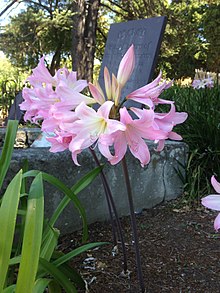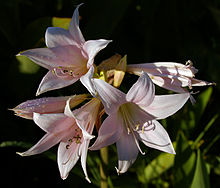Amaryllis
| Amaryllis | |
|---|---|

| |
| Amaryllis belladonna | |
| Scientific classification | |
| Kingdom: | Plantae |
| Clade: | Tracheophytes |
| Clade: | Angiosperms |
| Clade: | Monocots |
| Order: | Asparagales |
| Family: | Amaryllidaceae |
| Subfamily: | Amaryllidoideae |
| Tribe: | Amaryllideae |
| Genus: | Amaryllis L. |
| Type species | |
| Amaryllis belladonna L.
| |
| Species | |
Amaryllis(/ˌæməˈrɪlɪs/)[1]is the onlygenusin thesubtribeAmaryllidinae (tribeAmaryllideae). It is a small genus of floweringbulbs,with two species. The better known of the two,Amaryllis belladonna,is anativeof theWestern Caperegion of South Africa, particularly the rocky southwest area between theOlifants RiverValley andKnysna.[2]
For many years there was confusion among botanists over the generic namesAmaryllisandHippeastrum,one result of which is that the common name 'amaryllis' is mainly used forcultivarsof the genusHippeastrum,widely sold in the winter months for their ability tobloomindoors.
Plants of the genusAmaryllisare known as belladonna lily, Jersey lily, naked lady, amarillo, Easter lily in Southern Australia or, in South Africa, March lily due to its propensity to flower around March. This is one of numerous genera with the common name 'lily' due to their flower shape and growth habit. However, they are only distantly related to the true lily,Lilium.In the Victorianlanguage of flowers,amaryllis means "love, beauty, and determination", and can also represent hope and achievement.[3]
Description[edit]

Amaryllisis abulbousplant, with each bulb being 5–10 cm (2.0–3.9 in) in diameter. It has several strap-shaped,hysteranthous,greenleaveswithmidrib,30–50 cm (12–20 in) long and 2–3 cm (0.79–1.18 in) broad, arranged in two rows.
Each bulb produces one or two leafless, stout, persistent and erect stems 30–60 cm (12–24 in) tall, each of which bears at the top a cluster of two to twelvezygomorphic,funnel-shapedflowerswithout a tube. Each flower is 6–10 cm (2.4–3.9 in) in diameter with six spreadingtepals(three outer sepals, three inner petals, with similar appearance to each other). The usual color is white with crimson veins, but pink or purple also occur naturally.Stamensare very shortlyconnatebasally,declinate,unequal.Styleis declinate,stigmais three-lobed.Ovulesare approx. 8 perlocule.Seeds are compressed-globose, white to pink. The number ofchromosomesis 2n= 22.[4]
Taxonomy[edit]
The single genus is insubtribeAmaryllidinae, in the tribeAmaryllideae.The taxonomy of the genus has been controversial. In 1753Carl Linnaeuscreated the nameAmaryllis belladonna,thetype speciesof the genusAmaryllis.At the time both South African and South American plants were placed in the same genus; subsequently they were separated into two different genera. The key question is whether Linnaeus's type was a South African plant or a South American plant. If the latter,Amarylliswould be the correct name for the genusHippeastrum,and a different name would have to be used for the genus discussed here.Alan W. Meerowet al. have briefly summarized the debate, which took place from 1938 onwards and involved botanists on both sides of theAtlantic.The outcome was a decision by the 14th International Botanical Congress in 1987 thatAmaryllisL.should be a conserved name (i.e. correct regardless of priority) and ultimately based on a specimen of the South AfricanAmaryllis belladonnafrom theClifford Herbariumat theNatural History Museumin London.[5]
Species[edit]
As of October 2020[update],Amaryllishad only two accepted species, both native to theCape Provincesof South Africa:[6]
- Amaryllis belladonnaL.– south-west Cape Provinces; introduced into many parts of the world, including California, Great Britain, Australia and New Zealand[7]
- Amaryllis paradisicolaSnijman– west Cape Provinces
Phylogeny[edit]
Amaryllidinae are placed within Amaryllideae as follow:
These are phylogenetically related as follows:
| TribeAmaryllideae |
| ||||||||||||||||||
Etymology[edit]
The nameAmaryllisis taken from a shepherdess inVirgil's pastoralEclogues,(from theGreekἀμαρύσσω,amarysso,'to sparkle'.[8][9]
Although the 1987 decision settled the question of the scientific name of the genus, the common name 'amaryllis' continues to be used differently. Bulbs sold as amaryllis and described as "ready to bloom for the holidays" belong to the allied genusHippeastrum.[10]The common name "naked lady" comes from the plant's pattern of flowering when the foliage has died down. This name is also used for other bulbs with a similar growth and flowering pattern; some of these have their own widely used and accepted common names, such as the resurrection lily (Lycoris squamigera).[11]
Habitat[edit]
In areas of its native habitat with mountainousfynbos,flowering tends to be suppressed until after bush fires as dense overhead vegetation prevents growth. In more open sandy areas of the Western Cape, the plant flowers annually.[2]Plants tend to be very localized in dense concentrations due to the seeds' large size and heavy weight. Strong winds shake loose the seeds, which fall to ground and immediately start to germinate, aided by the first winter rains.[2]
Ecology[edit]
The leaves are produced in the autumn or early spring in warm climates depending on the onset of rain and eventually die down by late spring. The bulb is then dormant until late summer. The plant is not frost-tolerant, nor does it do well in tropical environments since they require a dry resting period between leaf growth and flower spike production.
One or two leafless stems arise from the bulb in the dry ground in late summer (March in its native habitat and August inUSDA zone 7).
The plant has asymbioticrelationship withcarpenter bees.It is also visited bynoctuid mothsat night. The relative importance of these insects as pollinators has not yet been established;[2]however, carpenter bees are thought to be the main pollinators of amaryllis on theCape Peninsula.The plant's main parasite is the lily borer[12]Brithys criniand/orDiaphone eumela.
Cultivation[edit]

Amaryllis belladonnawas introduced into cultivation at the beginning of the eighteenth century. It reproduces slowly by either bulb division or seeds and has gradually naturalized from plantings in urban and suburban areas throughout the lower elevations and coastal areas in much of the West Coast of the US since these environments mimic their native South African habitat. Hardiness zones 6–8.[13]It is also naturalized in Australia.[14]
There is anAmaryllis belladonnahybrid which was bred in the 1800s in Australia. No one knows the exact species it was crossed with to produce color variations of white, cream, peach, magenta and nearly red hues. The hybrids were crossed back onto the originalAmaryllis belladonnaand with each other to produce naturally seed-bearing crosses that come in a very wide range of flower sizes, shapes, stem heights and intensities of pink. Pure white varieties with bright green stems were bred as well. The hybrids are quite distinct in that the many shades of pink also have stripes, veining, darkened edges, white centers and light yellow centers, also setting them apart from the original light pink. In addition, the hybrids often produce flowers in a fuller circle rather than the "side-facing" habit of the "old-fashioned" pink. The hybrids are able to adapt to year-round watering and fertilization but can also tolerate completely dry summer conditions if need be.[citation needed]
A. belladonnahas gained theRoyal Horticultural Society'sAward of Garden Merit.[15]
Amaryllis belladonnahas been crossed in cultivation withCrinum mooreito produce a hybrid called×Amarcrinum,[16]which has named cultivars. Hybrids said to be betweenAmaryllis belladonnaandBrunsvigia josephinaehave been called ×Amarygia.[17]Neither hybrid genus name is accepted by theWorld Checklist of Selected Plant Families.[18]
See also[edit]
References[edit]
- ^Brenzel, Kathleen Norris (2001).The New Sunset Western Garden Book.Sunset Publishing. pp. 606–607.
- ^abcd"Amaryllis belladonna (March lily, Belladonna)".Biodiversity Explorer. Archived fromthe originalon 2018-01-25.RetrievedFebruary 2,2020.
- ^P., Rebekah (17 April 2020)."Amaryllis Flower Meaning and Symbolism".Florgeous.Retrieved19 October2020.
- ^Meerow, Alan W.;Snijman, Deirdre A.(1998). "Amaryllidaceae".InKubitzki, Klaus(ed.).The Families and Genera of Vascular Plants.Vol. III. Springer-Verlag Berlin Heidelberg GmbH. pp. 83–110.doi:10.1007/978-3-662-03533-7.ISBN978-3-642-08377-8.S2CID30159571.
- ^Meerow, Alan W.; Van Scheepen, Johan & Dutilh, Julie H.A. (1997), "Transfers fromAmaryllistoHippeastrum (Amaryllidaceae)",Taxon,46(1): 15–19,doi:10.2307/1224287,JSTOR1224287
- ^"AmaryllisL. "Plants of the World Online.Royal Botanic Gardens, Kew.Retrieved2020-10-19.
- ^"Amaryllis belladonaL. "Plants of the World Online.Royal Botanic Gardens, Kew.Retrieved2020-10-19.
- ^Mike Campbell."Behind the Name: Meaning, Origin and History of the Name Amaryllis".Behind the Name.
- ^Linné, Carl von. 1737. Hortus Cliffortianus. p. 135
- ^E.g.How to Make Your Amaryllis Bloom Again,The United States National Arboretum,retrieved2011-11-28
- ^Carter 2015.
- ^Adams, T (March 2001)."Amaryllis belladonna L."PlantZAfrica.RetrievedMarch 4,2013.
- ^"North Carolina State University".Archived fromthe originalon 2013-04-04.Retrieved2013-04-14.
- ^"Amaryllis belladonnaL. "Australian Plant Name Index(APNI), IBIS database.Centre for Plant Biodiversity Research, Australian Government.Retrieved4 March2014.
- ^"RHS Plant Selector –Amaryllis belladonna".Retrieved21 May2013.
- ^"Pacific Bulb Society – ×Amarcrinum".pacificbulbsociety.org.
- ^Plant Profile:Amarygia– Amaryllis belladonna x Brunsvigia josephinae,Australian Gardener, archived fromthe originalon 2012-03-22,retrieved2011-11-28
- ^World Checklist of Selected Plant Families,The Board of Trustees of theRoyal Botanic Gardens, Kew,retrieved2011-11-28,search for "Amarcrinum" and "Amarygia"
Sources[edit]
- Carter, Kathie."Amaryllis.Amaryllis belladonna(Brunsvigia rosea) andHippeastrumhybrids "(PDF).Center for Landscape and Urban Horticulture.Cooperative Extension/Botany Plant Sciences Dept. University California Riverside.Archived(PDF)from the original on 2022-10-09.Retrieved24 January2015.
External links[edit]
- Amaryllis– informative article about Amaryllis
